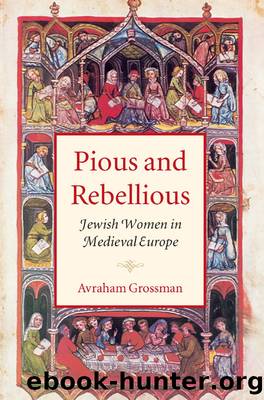Pious and Rebellious by Grossman Avraham;

Author:Grossman, Avraham;
Language: eng
Format: epub
Publisher: Brandeis University Press
6. Education of Women in Jewish Society
What was the situation in Jewish society in Muslim countries? R. Pethahiah of Regensburg described the widespread religious knowledge of Babylonian Jewry on the basis of what he observed during the second half of the twelfth century, and related that he did not encounter a single ignorant Jew “throughout the land of Babylonia, and in the land of Assyria and in the land of Media and Persia.”20
Pethahiah did not refer here to the level of education of Jewish women in Babylonia, and it is doubtful whether they received one similar to that of the men, as next to the above description he speaks of the great insistence upon feminine modesty in Jewish society, so much so that “one does not see any women there.” Under such strict conditions, it would be difficult for women to go out to study, although they could still study within their own homes with a relative or a learned woman—analogous to the practice among the elite families of Muslim society, as we saw above.
The Cairo Genizah preserves testimonies about small boys and girls who studied together in elementary primary schools. There were public schools and private schools, in which both male and female teachers taught. Nevertheless, as the goal of such elementary school education was to prepare those studying there to assume an active part in public worship, generally speaking only boys attended regularly. From the letters of women found in the Genizah, we learn that some of the women who received letters did not know to read them themselves and had need of others. However, the Genizah sources also preserve other testimonies of young girls and maidens who studied in school, and this also held true for the Alexandria community. One of them describes a class of young girls who studied with a blind teacher. The wealthy and elite families often insisted upon giving an advanced Jewish education to their daughters as well, usually by means of private teachers. However, the most impressive phenomenon is the mention of women among those poor who were literate, and often more than that. The woman mentioned in Maimonides’ responsum who served as a teacher also came from the poorest sector of Jewish society. One of the letters of the Genizah contains the will of a dying woman, who asked her sister to make sure that her daughter would continue her studies and be learned, as their mother had been. The sick woman is also not from a wealthy family:
My greatest charge to you is to take care of my youngest daughter and make an effort that she should learn. I know that I am imposing a great burden upon you, as we do not even have enough money to support her, all the more so for the expense of study.21
Women participated in synagogue worship. The Genizah fragments mention pious women who were meticulous about fulfilling mitzvot and making contributions to the synagogue. All these citations further support the assumption that there were those among them who were able to read Hebrew and to pray.
Download
This site does not store any files on its server. We only index and link to content provided by other sites. Please contact the content providers to delete copyright contents if any and email us, we'll remove relevant links or contents immediately.
| Africa | Americas |
| Arctic & Antarctica | Asia |
| Australia & Oceania | Europe |
| Middle East | Russia |
| United States | World |
| Ancient Civilizations | Military |
| Historical Study & Educational Resources |
Magic and Divination in Early Islam by Emilie Savage-Smith;(1450)
Ambition and Desire: The Dangerous Life of Josephine Bonaparte by Kate Williams(1274)
Papillon by Henry Charrière(1260)
Bohemians, Bootleggers, Flappers, and Swells: The Best of Early Vanity Fair by Bohemians Bootleggers Flappers & Swells- The Best of Early Vanity Fair (epub)(1256)
Twelve Caesars by Mary Beard(1135)
Operation Vengeance: The Astonishing Aerial Ambush That Changed World War II by Dan Hampton(1109)
What Really Happened: The Death of Hitler by Robert J. Hutchinson(1066)
London in the Twentieth Century by Jerry White(1046)
Time of the Magicians by Wolfram Eilenberger(1026)
Twilight of the Gods by Ian W. Toll(1020)
The Japanese by Christopher Harding(1017)
Lenin: A Biography by Robert Service(980)
The Devil You Know by Charles M. Blow(929)
Freemasons for Dummies by Hodapp Christopher;(889)
A Social History of the Media by Peter Burke & Peter Burke(883)
Napolean Hill Collection by Napoleon Hill(860)
The Churchill Complex by Ian Buruma(855)
The Rise and Triumph of the Modern Self by Unknown(852)
Henry III by David Carpenter;(846)
